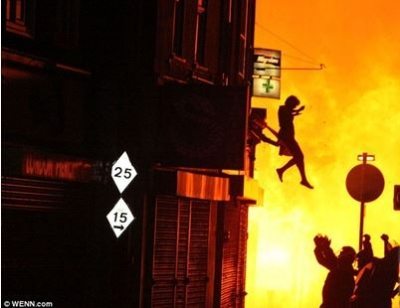As a potentially profitable opportunity presents itself, John will send you an alert with specific trade information as to what should be bought, when to buy it, and at what price. Read more
As a potentially profitable opportunity presents itself, John will send you an alert with specific trade information as to what should be bought, when to buy it, and at what price. This is your chance to ?look over? John Thomas? shoulder as he gives you unparalleled insight on major world financial trends BEFORE they happen.
Further Update to: Trade Alert -(SPY)
Buy the S&P 500 (SPY) May, 2014 $188-$191 in-the-money bear put spread at $2.43 or best
Opening Trade
4-14-2014
expiration date: May 16, 2014
Portfolio weighting: 30%
Number of Contracts: 125
This is a bet that the S&P 500 does not rocket to a new all time high by the May 16, 2014 expiration.
The news flow this morning is giving us an opportunity to re enter the short positions that I covered on Friday. Half of the opening 80-point pop in the Dow came from Citibank (C), which surprised to the upside with its Q1 earnings report.
We also got March retail sales +1.1%, better than expected.
We are down only 4.1% in this pullback, not even matching the 6% January dump, and we have clearly not suffered enough for our IPO sins. An eroding quantitative easing from Janet Yellen?s Federal Reserve is clearly taking a toll.
This rally could continue for a day or two more. But it has been so difficult to get short positions off in this correction that I don?t mind erring on the side of being a little early. The reversals ambush you at openings you can?t trade, and take no prisoners. We will probably get our reward on Friday in the next weekend flight to safety.
It is only because implied volatilities are so elevated that I can get this position so far out of the money off so richly, with only 23 trading days left until the May 16 expiration. The spring swoon has sent put prices through the roof, as panicking institutions rush to buy downside insurance a little too late.
Charts and technical analysis are far more useful and important in falling markets than rising one, as the downside crowd is far more dependent on this dismal science.
The fact that these charts are breaking down across markets on increasing volume is terrible news.
A sector rotation out of aggressive technology (XLK), financial (XLF), and discretionary stocks (XLY) into defensive consumer staples (XLP) and utilities (XLU) is a further complicating factor that is making matters worse.
Ten year Treasury yields approaching a five-month low is another nail in the coffin.
All that is needed is a match to ignite a broader, more vicious selloff and Russian Prime Minister Vladimir Putin has a whole box of them!
1,760 in the S&P 500, here we come, the 200-day moving average!
Keep in mind that fast markets, such as the one we have, I can get you only ballpark prices at best. It?s every man for himself. Praise the Lord, and pass the ammunition.
The best execution can be had by placing your bid for the entire spread in the middle market and waiting for the market to come to you. The difference between the bid and the offer on these deep in-the-money spread trades can be enormous.
Don?t execute the legs individually or you will end up losing much of your profit.
Keep in mind that these are ballpark prices only. Spread pricing can be very volatile on expiration months farther out.
Here are the specific trades you need to execute this position:
Buy 125 May, 2014 (SPY) $191 puts at?????$8.58
Sell short 125 May, 2014 (SPY) $188 puts at..??.$6.15
Net Cost:????????????????.....$2.43
Profit at expiration: $3.00 - $2.43 = $0.57
(125 X 100 X $0.57) = $7,125 or 7.13% profit for the notional $100,000 portfolio.
As a potentially profitable opportunity presents itself, John will send you an alert with specific trade information as to what should be bought, when to buy it, and at what price. This is your chance to ?look over? John Thomas? shoulder as he gives you unparalleled insight on major world financial trends BEFORE they happen. Read more
As a potentially profitable opportunity presents itself, John will send you an alert with specific trade information as to what should be bought, when to buy it, and at what price. This is your chance to ?look over? John Thomas? shoulder as he gives you unparalleled insight on major world financial trends BEFORE they happen.
Further Update to: Trade Alert -(SPY)
Sell the S&P 500 (SPY) May, 2014 $191-$194 in-the-money bear put spread at $2.86 or best
Closing Trade - not for new subscribers
4-11-2014
expiration date: May 16, 2014
Portfolio weighting: 10%
Number of Contracts = 42 contracts
Take the money and run. No one ever got fired for taking a profit. That?s the mood I was in when I came in and saw my long volatility ETF (VXX) spiking and my short in the S&P 500 (SPY) cratering.
It helped that Mad Day Trader Jim Parker, rushed the chart below to me right after the opening showing that the NASDAQ 100, the chief whipping boy in this selloff, is becoming severely oversold and fast approaching a major area of support (the lime green line). Bonds (TLT) are stalling at $110.60, and the ?RISK OFF? move in the Japanese yen (FXY) is approaching the upper limit of its 2014 range.
This all adds up to the possibility that another one of those ?rip your face off? short covering rallies could be near.
The rule in this type of market is to take the quick profits. You especially want to date, and not marry, the (VXX), since the contango over time can cost you your shirt.
Trading on the short side is a totally different animal than traditional long side plays. It is much harder work, as shorts behave totally differently than longs. The movie is on fast forward and you must act quickly.
To be up 15.45% so far in 2014, a down year when most investors are tearing their hair out, and up a meteoric 7.89% in April, is nothing less than heroic. The email plaudits have already started pouring in. Now all your friends at the country club can hate you, but only if you followed my advice.
Let me tell you what I did right this week, so you can take a page from the playbook of the master.
1) I kept the positions small, so I could sleep at night
2) I did the hard trade, selling when everyone else loved this market
3) I took trading profits quickly
4) I ignored the talking heads on TV so I wouldn?t puke out at the bottom
5) I didn?t take the Princess cruise from San Francisco to Los Angeles, where 50 passengers and 25 crew came down with norovirus. Imagine getting sick before you get to Mexico.
Is it possible that I am improving with age? That I?m becoming a better trader as I get older? That the payoff for a 45-year accumulation of market experience keeps increasing? What a concept!
I don?t think this correction is over. Vladimir Putin can drop a bombshell on the markets at any time. We are going into the traditional May-October ?RISK OFF? seasonal with markets still very near all time highs. The midterm elections in November are introducing a new level of uncertainty. The IPO bubble continues unabated (there are seven today!), and will only end in tears.
And who knows when another cruise ship is going to come down with norovirus?
But nothing moves in a straight line. It?s time to move to the sidelines so I can reload on the short side after the next short covering rally exhausts itself.
As for me, I am going to spend the rest of the day writing checks to the US Treasury to pay taxes for myself, the numerous entities I control, and a gaggle of impoverished relatives. All American tax returns are due on Tuesday.
Then I?m going down to Union Square in San Francisco and buy myself a new Brioni suit, another pair of Bruno Magli shoes, and have a kir royal at the top of the Mark Hopkins Hotel, thankful for my good fortune that I can pay all these bills.
The best execution can be had by placing your bid for the entire spread in the middle market and waiting for the market to come to you. The difference between the bid and the offer on these deep in-the-money spread trades can be enormous. Don?t execute the legs individually or you will end up losing much of your profit.
Keep in mind that these are ballpark prices only. Spread pricing can be very volatile on expiration months farther out.
Here are the specific trades you need to execute this position:
Sell 42 May, 2014 (SPY) $194 puts at?????$11.66
Buy to cover short 42 May, 2014 (SPY) $191 puts at..??.$8.80
Proceeds:??????????????????.....$2.86
Profit: $2.86 - $2.38 = $0.48
(42 X 100 X $0.48) = $2,016 or 2.02% profit for the notional $100,000 portfolio.
As a potentially profitable opportunity presents itself, John will send you an alert with specific trade information as to what should be bought, when to buy it, and at what price. Read more
As a potentially profitable opportunity presents itself, John will send you an alert with specific trade information as to what should be bought, when to buy it, and at what price. This is your chance to ?look over? John Thomas? shoulder as he gives you unparalleled insight on major world financial trends BEFORE they happen. Read more
As a potentially profitable opportunity presents itself, John will send you an alert with specific trade information as to what should be bought, when to buy it, and at what price. Read more
As a potentially profitable opportunity presents itself, John will send you an alert with specific trade information as to what should be bought, when to buy it, and at what price. This is your chance to ?look over? John Thomas? shoulder as he gives you unparalleled insight on major world financial trends BEFORE they happen. Read more
As a potentially profitable opportunity presents itself, John will send you an alert with specific trade information as to what should be bought, when to buy it, and at what price. This is your chance to ?look over? John Thomas? shoulder as he gives you unparalleled insight on major world financial trends BEFORE they happen.
Further Update to: Trade Alert -(SPY)
Sell the Currency Shares Japanese Yen Trust (FXY) May, 2014 $96-$99 in-the-money bear put spread at $2.35 or best
Closing Trade
4-8-2014
Closing Trade
expiration date: May 16, 2014
Portfolio weighting: 10%
Number of Contracts = 40 contracts
It was little after midnight west coast time when the Bank of Japan dropped its bombshell. It said it would refrain from stimulating the economy further to offset the deflationary effects of the VAT tax increase from 5% to 8%, which took effect on April 1.
Within seconds, the Japanese yen rocketed and never looked back. The Nikkei stock average crashed. Traders were stunned by the BOJ?s ill-timed move, as many GDP forecasts for the current quarter hover around the negative -1% level.
I held back on covering my yen short, waiting for a pullback. It was not to be, and I had to stop out with a small loss. Given the heightened level of anxiety in the markets since last week, I don?t have to be told twice to unload a ?RISK ON? position.
I am in the fortunate position in that I can offset this loss with the major gains I made on my short S&P 500 (SPY) and Russell 2000 (IWM) positions. This is why the word ?Hedge? is in the name ?Mad Hedge Fund Trader.?
However, the central bank said it would stick with its current plan to increase the money supply by 60-70 trillion yen per year for the next two years. One of Japan?s confidence indicators fell to the lowest level since 2011. The government is said to be mulling over a further VAT tax hike to 10%. So don?t count on the central bank to stick to the hard line for very long.
Many think that this is just a speed bump on Japan?s road to economic recovery, and that more stimulus is on its way in July, once the magnitude of the current slowdown is indisputable. This could just be another case of central banks slow to adapt to reality, as they are often wont to do.
?Oh, how I despise the yen, let me count the ways.? I?m sure Shakespeare would have come up with a line of iambic pentameter similar to this if he were a foreign exchange trader. I firmly believe that a short position in the yen should be at the core of any hedged portfolio for the next decade.
To remind you why you hate the currency of the land of the rising sun, I?ll refresh your memory with this short list:
* With the world?s structurally weakest major economy, Japan is certain to be the last country to raise interest rates. Interest rate differentials are the greatest driver of foreign exchange rates.
* This is inciting big hedge funds to borrow yen and sell it to finance longs in every other corner of the financial markets.
* Japan has the world?s worst demographic outlook that assures its problems will only get worse. They?re not making enough Japanese any more.
* The sovereign debt crisis in Europe is prompting investors to scan the horizon for the next troubled country. With gross debt well over a nosebleed 240% of GDP, or 120% when you net out inter agency crossholdings, Japan is at the top of the list.
* The Japanese long bond market, with a yield of only 0.61%, is a disaster waiting to happen.
* You have two willing co-conspirators in this trade, the Ministry of Finance and the Bank of Japan, who will move Mount Fuji if they must to get the yen down and bail out the country?s beleaguered exporters.
When the big turn inevitably comes, we?re going to ?110, then ?120, then ?150. That works out to a price of $200 for the (YCS), which last traded at $65. But it might take a few years to get there.
If you think this is extreme, let me remind you that when I first went to Japan in the early seventies, the yen was trading at ?305, and had just been revalued from the Peace Treaty Dodge line rate of ?360. To me the ?83 I see on my screen today is unbelievable. That would then give you a neat 17-year double top.
The best execution can be had by placing your bid for the entire spread in the middle market and waiting for the market to come to you. The difference between the bid and the offer on these deep in-the-money spread trades can be enormous. Don?t execute the legs individually or you will end up losing much of your profit.
Keep in mind that these are ballpark prices only. Spread pricing can be very volatile on expiration months farther out.
Here are the specific trades you need to execute this position:
Sell 40 May, 2014 (FXY) $99 puts at?????$3.30
Buy to cover short 40 May, 2014 (FXY) $96 puts at..??.$0.95
Net Cost:??????????????????.....$2.35
Loss: $2.50 - $2.35 = -$0.15
(40 X 100 X -$0.15 ) = -$600 or -0.60% loss for the notional $100,000 portfolio.
As a potentially profitable opportunity presents itself, John will send you an alert with specific trade information as to what should be bought, when to buy it, and at what price. Read more
Legal Disclaimer
There is a very high degree of risk involved in trading. Past results are not indicative of future returns. MadHedgeFundTrader.com and all individuals affiliated with this site assume no responsibilities for your trading and investment results. The indicators, strategies, columns, articles and all other features are for educational purposes only and should not be construed as investment advice. Information for futures trading observations are obtained from sources believed to be reliable, but we do not warrant its completeness or accuracy, or warrant any results from the use of the information. Your use of the trading observations is entirely at your own risk and it is your sole responsibility to evaluate the accuracy, completeness and usefulness of the information. You must assess the risk of any trade with your broker and make your own independent decisions regarding any securities mentioned herein. Affiliates of MadHedgeFundTrader.com may have a position or effect transactions in the securities described herein (or options thereon) and/or otherwise employ trading strategies that may be consistent or inconsistent with the provided strategies.

















